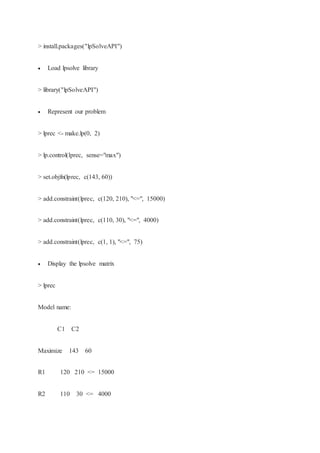Linear Programming wi̇th R - Examples
- 1. Prepared by Volkan OBAN LINEAR PROGRAMMING WİTH R— lpsolve and IpSolveAPI Package: The lpSolveAPI package provides an R API for the lp solve library, a mixed integer linear pro gramming (MILP) solver with support for pure linear, (mixed) integer/binary, semi-continuou s and special ordered sets (SOS) models. The lp solve library uses the revised simplex method to solve pure linear programs and uses the branch-and-bound algorithm to handle integer varia bles, semi-continuous variables and special ordered sets. Example: maximize P = (110)(1.30)x + (30)(2.00)y = 143x + 60y subject to 120x + 210y <= 15000 110x + 30y <= 4000 x + y <= 75 x >= 0 y >= 0 Using R to solve Install lpsolve library
- 2. > install.packages("lpSolveAPI") Load lpsolve library > library("lpSolveAPI") Represent our problem > lprec <- make.lp(0, 2) > lp.control(lprec, sense="max") > set.objfn(lprec, c(143, 60)) > add.constraint(lprec, c(120, 210), "<=", 15000) > add.constraint(lprec, c(110, 30), "<=", 4000) > add.constraint(lprec, c(1, 1), "<=", 75) Display the lpsolve matrix > lprec Model name: C1 C2 Maximize 143 60 R1 120 210 <= 15000 R2 110 30 <= 4000
- 3. R3 1 1 <= 75 Kind Std Std Type Real Real Upper Inf Inf Lower 0 0 Solve > solve(lprec) [1] 0 Get maximum profit > get.objective(lprec) [1] 6315.625 Get the solution > get.variables(lprec) [1] 21.875 53.125 Thus, to achieve the maximum profit ($6315.625), the farmer
- 4. Example: Model name: C1 C2 Minimize -2 -1 R1 1 3 <= 4 R2 1 1 <= 2 R3 2 0 <= 3 >install.packages("lpSolveAPI") library(lpSolveAPI) > > my.lp <- make.lp(3, 2) > > my.lp Model name: C1 C2 Minimize 0 0 R1 0 0 free 0 R2 0 0 free 0 R3 0 0 free 0 Kind Std Std Type Real Real Upper Inf Inf Lower 0 0 > set.column(my.lp, 1, c(1, 1, 2)) > > set.column(my.lp, 2, c(3, 1, 0)) > > set.objfn(my.lp, c(-2, -1)) > > set.constr.type(my.lp, rep("<=", 3)) > > set.rhs(my.lp, c(4, 2, 3)) > my.lp Model name: C1 C2 Minimize -2 -1 R1 1 3 <= 4 R2 1 1 <= 2 R3 2 0 <= 3 Kind Std Std Type Real Real Upper Inf Inf Lower 0 0
- 5. > solve(my.lp) [1] 0 > > get.objective(my.lp) [1] -3.5 > > get.variables(my.lp) [1] 1.5 0.5 > > get.constraints(my.lp) [1] 3 2 3 Example: First, we create an LPMO with 3 constraints and 4 decision variables. > lprec <- make.lp(3, 4) Next we set the values in the first column. > set.column(lprec, 1, c(0, 0.24, 12.68)) The lp solve library is capable of using a sparse vectors to represent the constraints matrix. In the remaining three columns, only the nonzero entries are set. > set.column(lprec, 2, 78.26, indices = 1) > set.column(lprec, 3, c(11.31, 0.08), indices = 2:3) > set.column(lprec, 4, c(2.9, 0.9), indices = c(1, 3)) Next, we set the objective function, constraint types and right-hand-side. > set.objfn(lprec, c(1, 3, 6.24, 0.1)) > set.constr.type(lprec, c(">=", "<=", ">=")) > set.rhs(lprec, c(92.3, 14.8, 4)) By default, all decision variables are created as real with range [0,∞). Thus we must change the type of the decision variables x2 and x3.
- 6. > set.type(lprec, 2, "integer") > set.type(lprec, 3, "binary") We still need to set the range constraints on x1 and x4. > set.bounds(lprec, lower = c(28.6, 18), columns = c(1, 4)) > set.bounds(lprec, upper = 48.98, columns = 4) Finally, we name the decision variables and the constraints. > RowNames <- c("THISROW", "THATROW", "LASTROW") > ColNames <- c("COLONE", "COLTWO", "COLTHREE", "COLFOUR") > dimnames(lprec) <- list(RowNames, ColNames) Lets take a look at what we have done so far. [1] 92.3000 6.8640 391.2928



![R3 1 1 <= 75
Kind Std Std
Type Real Real
Upper Inf Inf
Lower 0 0
Solve
> solve(lprec)
[1] 0
Get maximum profit
> get.objective(lprec)
[1] 6315.625
Get the solution
> get.variables(lprec)
[1] 21.875 53.125
Thus, to achieve the maximum profit ($6315.625), the farmer](https://image.slidesharecdn.com/linearprogrammingwithr-170725131851/85/Linear-Programming-wi-th-R-Examples-3-320.jpg)

![> solve(my.lp)
[1] 0
>
> get.objective(my.lp)
[1] -3.5
>
> get.variables(my.lp)
[1] 1.5 0.5
>
> get.constraints(my.lp)
[1] 3 2 3
Example:
First, we create an LPMO with 3 constraints and 4 decision variables.
> lprec <- make.lp(3, 4)
Next we set the values in the
first column. > set.column(lprec, 1, c(0, 0.24, 12.68))
The lp solve library is capable of using a sparse vectors to represent the constraints matrix. In
the remaining three columns, only the nonzero entries are set.
> set.column(lprec, 2, 78.26, indices = 1)
> set.column(lprec, 3, c(11.31, 0.08), indices = 2:3)
> set.column(lprec, 4, c(2.9, 0.9), indices = c(1, 3))
Next, we set the objective function, constraint types and right-hand-side.
> set.objfn(lprec, c(1, 3, 6.24, 0.1))
> set.constr.type(lprec, c(">=", "<=", ">="))
> set.rhs(lprec, c(92.3, 14.8, 4))
By default, all decision variables are created as real with range [0,∞). Thus we must change
the type of the decision variables x2 and x3.](https://image.slidesharecdn.com/linearprogrammingwithr-170725131851/85/Linear-Programming-wi-th-R-Examples-5-320.jpg)
![> set.type(lprec, 2, "integer")
> set.type(lprec, 3, "binary")
We still need to set the range constraints on x1 and x4.
> set.bounds(lprec, lower = c(28.6, 18), columns = c(1, 4))
> set.bounds(lprec, upper = 48.98, columns = 4) Finally, we name the decision variables and
the constraints.
> RowNames <- c("THISROW", "THATROW", "LASTROW")
> ColNames <- c("COLONE", "COLTWO", "COLTHREE", "COLFOUR")
> dimnames(lprec) <- list(RowNames, ColNames)
Lets take a look at what we have done so far.
[1] 92.3000 6.8640 391.2928](https://image.slidesharecdn.com/linearprogrammingwithr-170725131851/85/Linear-Programming-wi-th-R-Examples-6-320.jpg)
